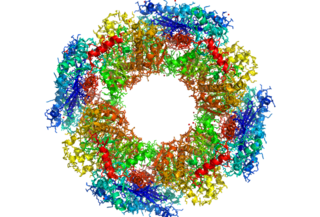
3-Dehydrocarnitine is an aliphatic quaternary ammonium betaine that is part of the carnitine family. At physiological pH of 7.3, the major species of 3-dehydrocarnitine is its zwitterionic form, the conjugate base of 3-dehydrocarnitinium. 3-Dehydrocarnitine is classified as a short-chain keto acid, as it has a carbon chain containing less than six carbon atoms. It is an intermediate in carnitine degradation and is formed from D- or L-carnitine. The enzymes responsible for the degradation of carnitine to 3-dehydrocarnitine are carnitine-3-dehydrogenase or (S)-carnitine-3-dehydrogenase.
In enzymology, a 4-hydroxybenzoate 1-hydroxylase (EC 1.14.13.64) is an enzyme that catalyzes the chemical reaction
In enzymology, a 6-hydroxynicotinate dehydrogenase (EC 1.17.3.3) is an enzyme that catalyzes the chemical reaction
In enzymology, a 1-hydroxy-2-naphthoate 1,2-dioxygenase (EC 1.13.11.38) is an enzyme that catalyzes the chemical reaction
In biochemistry, NAD(P)+ transhydrogenase (Si-specific) (EC 1.6.1.1) is an enzyme that catalyzes the chemical reaction
Pectin lyase, also known as pectolyase, is a naturally occurring pectinase, a type of enzyme that degrades pectin. It is produced commercially for the food industry from fungi and used to destroy residual fruit starch, known as pectin, in wine and cider. In plant cell culture, it is used in combination with the enzyme cellulase to generate protoplasts by degrading the plant cell walls.

In enzymology, a butyrate kinase is an enzyme that catalyzes the chemical reaction
Agarase is an enzyme with systematic name agarose 4-glycanohydrolase. It is found in agarolytic bacteria and is the first enzyme in the agar catabolic pathway. It is responsible for allowing them to use agar as their primary source of carbon and enables their ability to thrive in the ocean.
Cunninghamella elegans is a species of fungus in the genus Cunninghamella found in soil.
Vinylphenol reductase is an enzyme that catalyses the reaction :
6-hydroxypseudooxynicotine dehydrogenase (EC 1.5.99.14) is an enzyme with systematic name 1-(6-hydroxypyridin-3-yl)-4-(methylamino)butan-1-one:acceptor 6-oxidoreductase (hydroxylating). This enzyme catalyses the following chemical reaction:
6-hydroxy-3-succinoylpyridine 3-monooxygenase (EC 1.14.13.163, 6-hydroxy-3-succinoylpyridine hydroxylase, hspA (gene), hspB (gene)) is an enzyme with systematic name 4-(6-hydroxypyridin-3-yl)-4-oxobutanoate,NADH:oxygen oxidoreductase (3-hydroxylating, succinate semialdehyde releasing). This enzyme catalyses the following chemical reaction
Phosphoserine transaminase is an enzyme with systematic name O-phospho-L-serine:2-oxoglutarate aminotransferase. This enzyme catalyses the following chemical reaction
2-haloacid dehalogenase (configuration-inverting) (EC 3.8.1.10, 2-haloalkanoic acid dehalogenase, 2-haloalkanoid acid halidohydrolase, DL-2-haloacid dehalogenase, DL-2-haloacid dehalogenase (inversion of configuration), DL-2-haloacid halidohydrolase (inversion of configuration), DL-DEXi, (R,S)-2-haloacid dehalogenase (configuration-inverting)) is an enzyme with systematic name (S)-2-haloacid dehalogenase (configuration-inverting). This enzyme catalyses the following chemical reaction
Pseudarthrobacter chlorophenolicus is a species of bacteria capable of degrading high concentrations of 4-chlorophenol, hence its name. As such, it may be useful in bioremediation.
Methanococcoides methylutens is a methylotrophic marine methanogen, the type species of its genus. It utilises trimethylamine, diethylamine, monomethylamine, and methanol as substrates for growth and methanogenesis. Cells are non-motile, non-spore-forming, irregular cocci 1 μm in diameter which stain Gram-negative and occur singly or in pairs. TMA-10 is the type strain.
Oxalotrophic bacteria are bacteria capable of using oxalate as their sole source of carbon and energy. Oxalate is the anion of a salt of oxalic acid; oxalotrophs often consume calcium oxalate. Oxalotrophic bacteria are often facultative methylotrophs.
Sphingomonas astaxanthinifaciens is a bacterium from the genus of Sphingomonas which has been isolated from fresh water in Misasa in Japan. Sphingomonas astaxanthinifaciens has the ability to produce astaxanthin.
Acidipila is a bacterial genus from the family of Acidobacteriaceae. All reported examples have been isolated from acidic substrates and are capable of growth on sugars

2-Fluorobenzoic acid is an aromatic organic compound with the formula FC6H4CO2H. It is one of three isomeric fluorobenzoic acids. Its conjugate base is 2-fluorobenzoate. The compound is an irritant.



